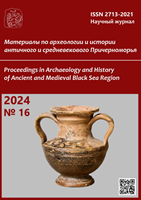К вопросу о датировке посвятительной надписи Аспурга, найденной в 2013 г. в Горгиппии
On the question of dating the dedicatory inscription of Aspurgus found in 2013 in Gorgippia
Author(s): Michael ChorefSubject(s): Archaeology, Cultural history, Social history
Published by: Нижневартовский государственный университет
Keywords: archaeology; history; epigraphy; Bosporus; Aspurgus;
Summary/Abstract: Obtaining objective ideas about historical phenomena and processes is only possible as a result of a comprehensive study of the widest possible range of various sources of information suitable for covering them. This is for the reason that the historical evidence may be unreliable, contradictory, poorly preserved or misinterpreted. Hence, an unbiased and scrupulous criticism of both the evidence and the results of its study is necessary. It is this approach which helps to avoid unfounded or erroneous conclusions. The author illustrates these theses using the example of the dedicatory inscription of Aspurgus placed on a marble pedestal found in Gorgippia in 2013. The artifact was studied and published by N.V. Zavoikina, A.M. Novichikhin, and V.A. Konstantinov. Judging by the fact that Aspurgus is presented there as φιλορώμαιος, he was recognized by Rome at that time. However, he did not have the titles βασιλεὺς μέγας and φιλοκαίσαρος being only proud of his descent from βασιλέως μεγάλου Ἀσανδρόχου. So there is every reason to date the inscription back to the early years of his reign. The author’s interest in this inscription stems from the fact that the discoverers dated it back to 303 BE (6/7 CE), and it was this very basis on which they concluded that Aspurgus had ascended the Bosporan throne by that time. But this proposal contradicts with numismatic data. Specifically, staters with monograms of this sovereign, containing an indication of the royal title, have started to be minted as early as in 311 BE (14/15 CE). The author is forced to note that the researchers misread the date given in the last line of the inscription, and insists that the text under study was carved in 315 BE (18/19 CE). Hence, there is no reason to reinterpret generally accepted ideas about the date of proclaiming Aspurgus the king of the Bosporus.
Journal: Материалы по археологии и истории античного и средневекового Причерноморья
- Issue Year: 2024
- Issue No: 16
- Page Range: 811-835
- Page Count: 25
- Language: Russian

